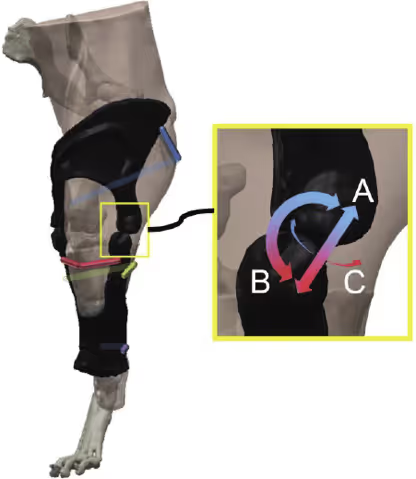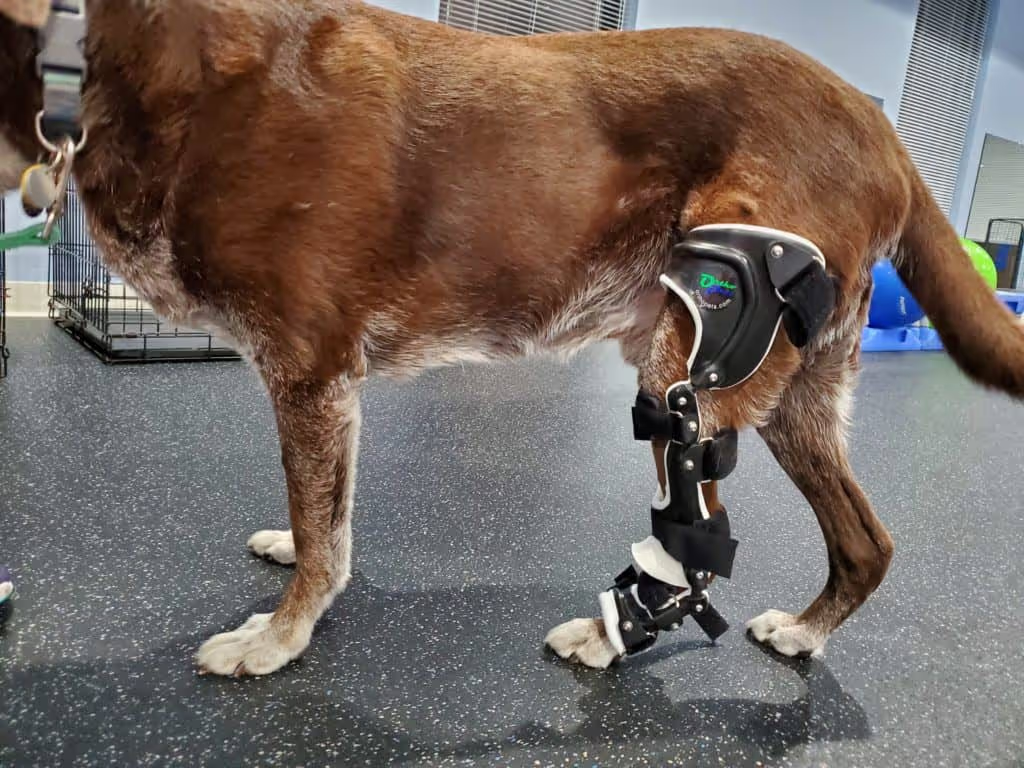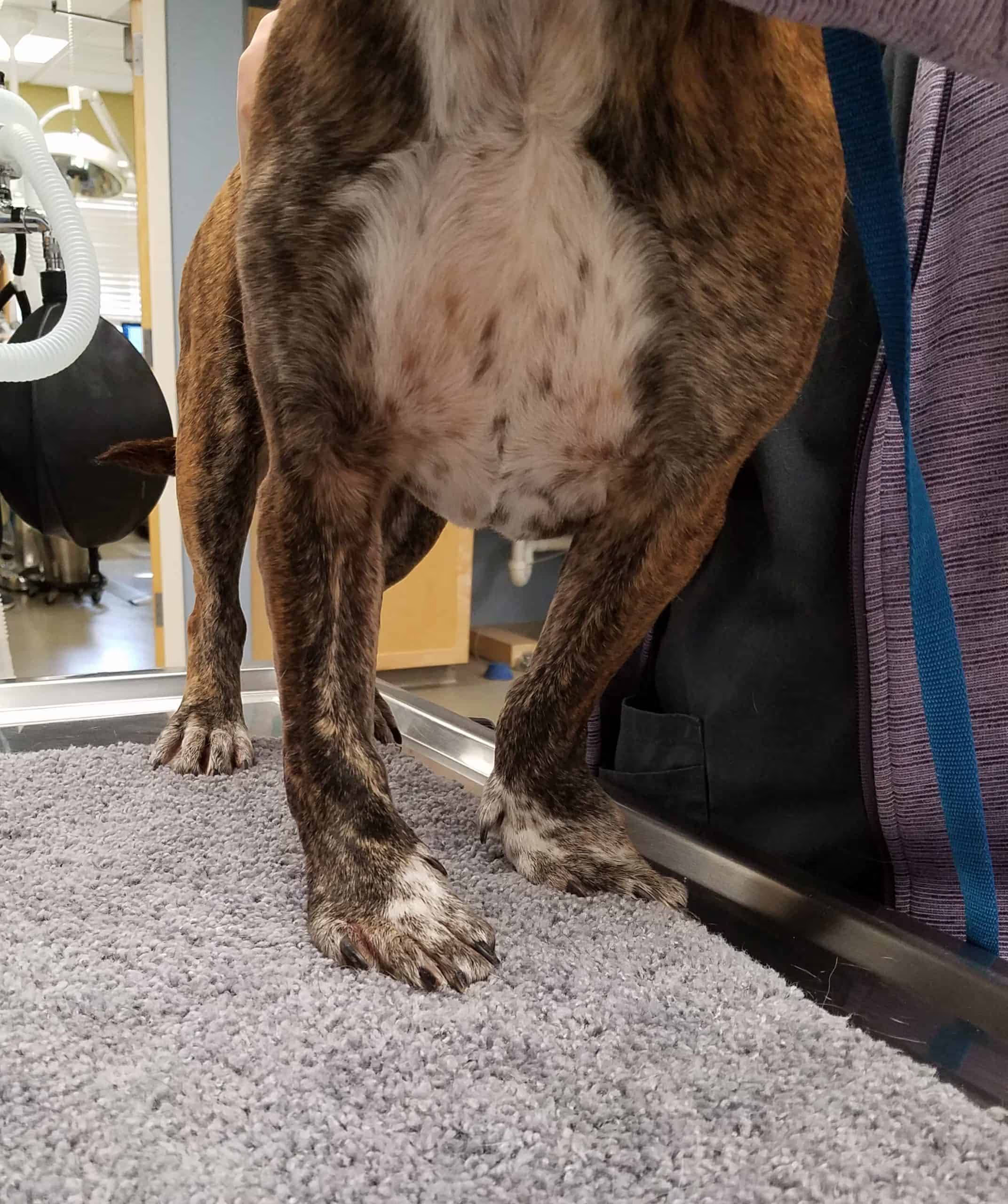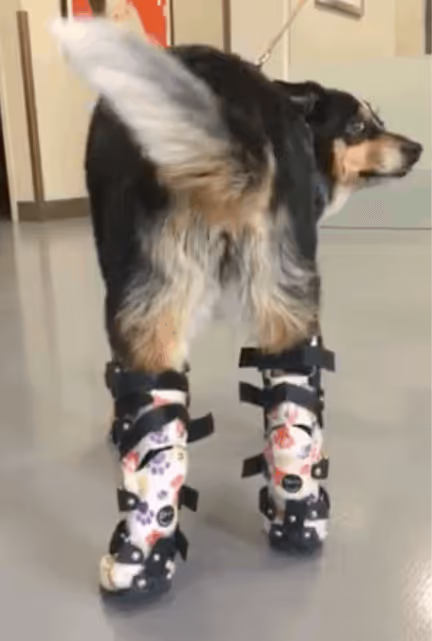OrthoPets ACORN Stifle Study- University of Louisville Stifle Brace Study

Bertocci, Gina E., and Nathan P. Brown, "Biomechanics of an orthosis-managed cranial cruciate ligament-deficient canine stifle joint predicted by use of a computer model." American Journal of Veterinary Research 78.1 (2017): 27-35.http://avmajournals.avma.org/doi/abs/10.2460/ajvr.78.1.27

OBJECTIVE
To evaluate effects of an orthosis on biomechanics of a cranial cruciate ligament (CrCL)–deficient canine stifle joint by use of a 3-D quasistatic rigid-body pelvic limb computer model simulating the stance phase of gait and to investigate influences of orthosis hinge stiffness (durometer).
SAMPLE
A previously developed computer simulation model for a healthy 33-kg 5-year-old neutered Golden Retriever.
PROCEDURES
A custom stifle joint orthosis was implemented in the CrCL-deficient pelvic limb computer simulation model. Ligament loads, relative tibial translation, and relative tibial rotation in the orthosis-stabilized stifle joint (baseline scenario; high-durometer hinge) were determined and compared with values for CrCL-intact and CrCL-deficient stifle joints. Sensitivity analysis was conducted to evaluate the influence of orthosis hinge stiffness on model outcome measures.
RESULTS
The orthosis decreased loads placed on the caudal cruciate and lateral collateral ligaments and increased load placed on the medial collateral ligament, compared with loads for the CrCL-intact stifle joint. Ligament loads were decreased in the orthosis-managed CrCL-deficient stifle joint, compared with loads for the CrCL-deficient stifle joint. Relative tibial translation and rotation decreased but were not eliminated after orthosis management. Increased orthosis hinge stiffness reduced tibial translation and rotation, whereas decreased hinge stiffness increased internal tibial rotation, compared with values for the baseline scenario.
CONCLUSIONS AND CLINICAL RELEVANCE
Stifle joint biomechanics were improved following orthosis implementation, compared with biomechanics of the CrCL-deficient stifle joint. Orthosis hinge stiffness influenced stifle joint biomechanics. An orthosis may be a viable option to stabilize a CrCL-deficient canine stifle joint.
Key points

Introduction:
- Orthoses for CCLD have been reported. Their efficacy is dependent on device, owner, care-provider (adjustment, fitting of device and rehabilitation) and animal factors.
- Orthosis allows limited functional movement (rather than complete immobilization) according to 4-point force application system used in humans with ACL-tears with the following cranial constraints (quads, tibial tuberosity, distal tibia) and caudal constraints (semimembranosus and semitendinosus, gastrocnemius muscles and calcanean tendon)
- However, stabilizing effect of canine stifle orthosis has not been investigated
Materials and Methods:
- Previously developed and validated computer model (3-D quasi-static based on 33kg Golden Retriever) utilized to test Orthopets CCLD-orthosis (with 2 Tamarack hinges at stifle) that was molded specifically for the dog that the computer model was based on
- A 3-D scan of the orthosis was then performed to import the orthosis into the previously developed stifle model and loads on the ligaments (caudal CL, MCL, LCL) and tibial rotation and translation (drawer) through stance phase were compared between CrCL-intact, CrCL-deficient and CrCl-intact and -deficient with Orthopets orthosis
- Different hinge stiffness (Tamarack 740-L [high] and Vet-L-65 [low stiffness]) were also evaluated
Results:
- CrCL-deficient stifle compared to orthosis-managed CrCL-deficient stifle showed reduced tibial translation (91%) and rotation (61%)
- CrCL-intact stifle compared to orthosis (with CrCL-intact stifle) showed significantly different peak loads (i.e. orthosis changes the loads compared to an intact stifle): Loads on the caudal cruciate (38%) and lateral collateral ligament (53%) were reduced while MCL increased (50%)
- CrCL-deficient stifle compared to orthosis-managed CrCL-deficient stifle showed significantly decreased peak loads for all ligaments tested: Caudal cruciate (90%), lateral collateral ligament (93%) and MCL (59%)
- Hinge stiffness significantly impacted tibial rotation (decreasing rotation with increasing hinge stiffness)
Discussion:
- Stifle orthosis for CrCL-deficient stifle reduced translational instability by 90% in this computer-model The tested device (Orthopets stifle orthosis) significantly improved biomechanical stifle stability in the stifle with cranial cruciate ligament deficiency
- Stifle orthosis for CrCL-deficient stifle decreased loads on the collateral ligaments and caudal cruciate ligaments in this computer-model
- The tested device (Orthopets stifle orthosis) may prevent subsequent injury to ligamentous structures
- The tested design appears to reduce loading of the lateral collateral ligament to a greater degree than medial collateral ligament
- Hinge stiffness had the greatest impact on tibial rotation If greater control of internal tibial rotation is required (such as pivot-shift cases) a stiffer hinge should be considered
- While computer models have been previously validated and appear highly predictive some variables are introduced when using a ‘real’ patient that may change these results (such as the cuffs were ‘modeled’ as a straight line, the foam may compress over time etc.) – in other words the result of this model are likely superior to what can be accomplished in a clinical patient
- Modeling limited because it was based on one patient at one time-point only




